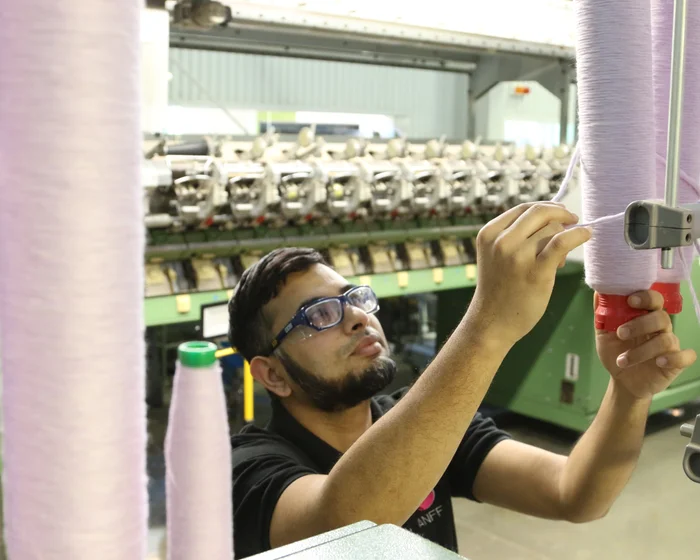At the Future Fibres Facility at the Deakin Institute for Frontier Materials in Geelong, Victoria, newly spun spools of richly coloured premium yarns line the walls, offering fashion and textile designers a dizzying display of design possibilities. More than just a source of inspiration, these yarns were created in the quest for a more sustainable fibre that has the potential to pave the way for more locally made, low-impact Australian fashion.
The yarns spun by Deakin researchers are the result of a 20-month partnership with Full Circle Fibres, founded by the textile technologist Meriel Chamberlin; and Sam Van Zyl, the CEO of LoomTex, a dyeing and weaving facility in Geelong.
Chamberlin wanted to see if it was possible to create a super-low-impact yarn blending locally grown lower-grade short wool and first-quality Australian cotton. So she turned to Deakin for its expertise and capability in spinning, piloting, testing and sampling. LoomTex assisted with dyeing the fibre, and weaving the final product. The Mud to Marle project (marle is a colour effect achieved by mixing two yarns) was one of the first to receive a grant from the Country Road Climate Fund, a scheme that supports climate solutions in the fashion industry.
Associate Professor Christopher Hurren leads a team of about 15 research and support staff and PhD students who travel from all over the world to work on new fibre research projects at Deakin’s Australian Research Council Research Hub for Future Fibres. As well as Mud to Marle, the hub has recently worked on seaweed-based textiles, motorcycle clothing safety testing, microplastic shredding mitigation and pigment recycling. It focuses on sustainability throughout the supply chain.
“Eighty to 90% of those textile-based projects are around circularity, or lowering the energy and the impact of textiles,” Hurren says. “The hub’s work is about getting partners from a concept through to a product you can put on or feel or touch, because the textile industry is very much about that.” The hub’s specialisation has become so sought after that two or three companies a week approach the facility to discuss circularity, he says.
Deakin’s lab has the flexibility to work with various quantities, making it a desirable partner for textile testing and research. “We can take 20 grams of fibre and take that through to a yarn, or we can take 50kg of fibre,” Hurren says. “We’re able to do a whole lot of research with our 20-gram lots, work out what is the best, and then scale that to a much larger run.”
The Mud to Marle project focused on locks: short lengths of wool from the sheep’s belly, legs and the top of the head, the “muddy” parts, and tested them to discover which processes would create a sustainable, viable and desirable fibre blend.
The goal was to prove that low-impact, high-grade textiles could be made using natural fibres from Australia, and turned into finished garments in Australia, too, Hurren says.
Deakin, Full Circle Fibres and LoomTex used uncommon production pathways to create the yarn. Instead of dyeing the fabric after it had been made, they dyed the wool fibre first. Then the wool was blended with undyed cotton as it was spun on cotton-spinning equipment, which, unlike traditional wool spinners, could work with short lengths. The mixture of dyed wool and undyed cotton created a plastic-free marle thread that is normally achieved with polyester and cotton blends.
“Typically, you would blend the wool and the cotton together, spin them and then colour them afterwards,” Hurren says. “By only dyeing the wool component, we significantly reduced the amount of water, chemicals and energy required to colour our textile.
“It was quite important for us to play with this, because a lot of the recycled fibre that [the industry is] about to start using is [already] coloured. We weren’t using recycled content, but it was a prelude to understanding how we’re going to deal with recycled textiles.”
Mud to Marle has shown that a desirable, premium product can be sustainably created from waste.
Chamberlin says creating something beautiful to touch and look at is not just a side-effect; it’s the point. “We can do all the work in the world to make a low-impact product, but unless the product is something beautiful that people want to wear, enjoy wearing, can look after and is going to last, it’s all for nothing,” she says.


